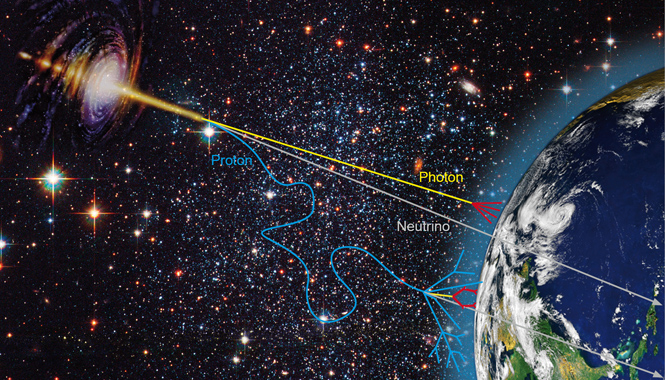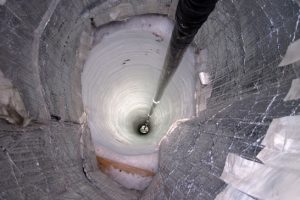The field of particle astrophysics is at the forefront of research in both high-energy particle physics and astronomy. In The University of Alabama particle astrophysics group, we use fundamental particles to explore some of the most extreme objects in the universe, and use astronomical signals to explore physics beyond the Standard Model.

IceCube Neutrino Observatory

IceCube is the largest neutrino detector on Earth. Located at the geographic South Pole, IceCube consists of strings of photomultiplier tubes deployed between 1500 and 2500 meters deep in the Antarctic icecap. Construction of the IceCube detector was complete as of January 2011, with 86 strings instrumenting a cubic kilometer of ice. IceCube was built to detect astrophysical neutrinos at TeV-PeV energies from objects such as active galactic nuclei and gamma ray bursts, which are believed to be the source of the highest-energy cosmic rays.IceCube also searches for neutrinos from the annihilation of dark matter and explores fundamental aspects of neutrino physics with neutrinos produced by cosmic rays interacting in our atmosphere.
The group of Dr. Dawn Williams is involved in various aspects of calibration of large volume neutrino telescopes. Dr. Williams is a member of the IceCube Neutrino Observatory, IceCube-Gen2, and the Radio Neutrino Observatory — Greenland (RNO-G) collaborations. She is the co-convenor of the IceCube Neutrino Observatory calibration working group, the Level 2 Lead for Calibration and Characterization for the IceCube Upgrade project, and the Level 2 Lead for Detector Calibration and Commissioning for IceCube-Gen2. The Alabama IceCube group is also responsible for calibration of the detector with muons and LED flashers.
VERITAS Gamma Ray Observatory
VERITAS (Very Energetic Radiation Imaging Telescope Array System) is a ground-based gamma-ray instrument operating at the Fred Lawrence Whipple Observatory (FLWO) in southern Arizona, USA. It is an array of four 12m optical reflectors for gamma-ray astronomy in the GeV – TeV energy range. These imaging Cherenkov telescopes are deployed such that they have the highest sensitivity in the VHE energy band (50 GeV – 50 TeV), with maximum sensitivity from 100 GeV to 10 TeV. This VHE observatory effectively complements the NASA Fermi mission. Objects that emit gamma-rays are very interesting to astrophysicists. High-energy gamma rays are associated with exploding stars (supernovae), pulsars , quasars , and black holes rather than with ordinary stars or galaxies.
Dr. Marcos Santander is interested in multimessenger astrophysics, combining observations of high-energy neutrinos and gravitational waves with those collected by gamma-ray and X-ray telescopes to study some of the most powerful objects in the Universe, in particular active galactic nuclei. His group is involved in the IceCube neutrino telescope and the VERITAS gamma-ray telescope array, as well as in the development of two next-generation, ground-based gamma-ray observatories: CTA and SWGO. The group also leads observational programs using space-based instruments such as the Fermi gamma-ray space telescope, and the Swift, NICER and NuSTAR X-ray telescopes.

Astroparticle Theory
Dr. Nobuchika Okada’s research interests are centered on phenomenological aspects of particle physics, in particular, new physics beyond the Standard Model. It has been clear in recent years that an extension of the Standard Model, i.e. new physics beyond the Standard Model, is needed to explain a number of experimental observations such as dark matter. In addition, the Standard Model suffers from several theoretical problems. These problems are expected to be solved by a certain new physics which is realized most likely at the TeV scale.
The main theme of Dr. Okada’s research is to reveal new physics beyond the Standard Model from the theoretical point of view, based on the experimental results. Along this direction, Dr. Okada has been working on various topics of particle physics phenomenology such as new physics model buildings, supersymmetry, extra-dimensional models, grand unified theory, neutrino physics, high energy collider physics, particle cosmology, and astroparticle physics. See a list of publications here.
In addition to the faculty mentioned above, you can find more information about our astronomy faculty at this astronomy research overview page.
Contact Us
If you are a student (undergraduate or graduate) with a possible interest in astroparticle physics we would be glad to hear from you via e-mail or otherwise. Please contact one of the physicists above or email physgrad@ua.edu for information about graduate study. Information about our graduate program is also available on our website.